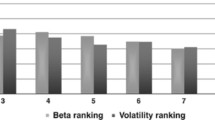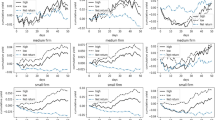Abstract
This paper presents empirical tests of the hypothesis that high-dividend-yield stocks offer investors significantly lower systematic risk in down markets. While high-yield stocks have lower levels of systematic risk overall, there is no evidence in this study that lower systematic risk is achieved in down markets for stocks with high-yield components in their total rates of return. This finding is robust over a variety of test procedures and provides additional support for dividend irrelevance propositions.
Similar content being viewed by others
References
Arbel, Avner, Steven Carvell, andErik Postnieks. “The Smart Crash of October 1987.”Harvard Business Review 66, no. 3 (May–June 1988): 124–36.
Black, Fisher. “Capital Market Equilibrium with Restricted Borrowing.”Journal of Business 45, no. 3 (July 1972): 444–55.
Blume, Marshall. “Stock Returns and Dividend Yields: Some More Evidence.”Review of Economics and Statistics 62, no. 4 (November 1980): 567–77.
Brennan, Michael. “Taxes, Market Valuation, and Corporate Financial Policy.”National Tax Journal 23, no. 4 (December 1970): 417–27.
Cohen, Jerome B., Edward D. Zinbarg, andArthur Zeikel.Investment Analysis and Portfolio Management. 5th ed. Homewood, IL: R. D. Irwin Co., 1987.
Elton, Edwin, andMartin Gruber. “Marginal Stockholder Tax Rates and the Clientele Effect.”Review of Economics and Statistics 52, no. 1 (February 1970): 68–74.
Fabozzi, Frank J., andJack Clark-Francis. “Stability Tests for Alphas and Betas over Bull and Bear Market Condition.”Journal of Finance 32, no. 4 (September 1977): 1093–99.
Graham, Benjamin, andDavid Dodd.Security Analysis: Principles and Techniques. New York, NY: McGraw-Hill, 1962.
Hess, Patrick. “Tests for Tax Effects in the Pricing of Financial Assets.”Journal of Business 56, no. 4 (October 1983): 445–56.
Johnston, John.Econometric Methods. 3d ed. New York, NY: McGraw-Hill Co., 1984.
Levy, Robert A.. “Beta Coefficients as Predictors of Returns.”Financial Analysts Journal 30, no. 1 (January–February 1974): 61–69.
Lintner, John. “Distribution of Incomes of Corporations Among Dividends, Retained Earnings, and Taxes.”American Economic Review 46, no. 2 (May 1956): 97–113.
Litzenberger, Robert, andKrishna Ramaswamy. “The Effect of Personal Taxes and Dividends on Capital Asset Prices: Theory and Empirical Evidence.”Journal of Financial Economics 7, no. 2 (June 1979): 163–96.
Litzenberger, Robert, andKrishna Ramaswamy. “The Effects of Dividends on Common Stock Prices: Tax Effects or Information Effects?”Journal of Finance 37, no. 2 (May 1982): 429–43.
Lynch, Peter. “Some Famous Numbers from ‘One Up on Wall Street’.”AAII Journal 11, no. 4 (April 1989): 8–12.
Markese, John. “Common Stock Dividends: What are they Worth?”AAII Journal 11, no. 7 (July 1989): 29–33.
Miller, Merton, andFranco Modigliani. “Dividend Policy, Growth, and the Valuation of Shares.”Journal of Business 34, no. 4 (October 1961): 411–33.
Miller, Merton, andMyron S. Scholes. “Dividends and Taxes.”Journal of Financial Economics 6, no. 4 (December 1978): 333–64.
Morgan, I.G.. “Dividends and Capital Asset Prices.”Journal of Finance 37, no. 4 (September 1982): 1071–85.
Rosenberg, Barr, andVinay Marathe. “Tests of the Capital Asset Pricing Hypothesis.”Research in Finance 1 (January 1979): 115–223.
Stevens, Jerry L., andMark Finn. “Investment Performance of an ‘Extreme Value’ Market-Timing Approach.”Journal of Financial Planning 3, no. 1 (January 1990): 28–35.
Stevens, Jerry L., andManuel L. Jose. “The Effects of Dividend Payout, Stability, and Smoothing on Firm Value.”Journal of Accounting, Auditing, and Finance 7, no. 2 (Spring 1992): 195–216.
Van Horne, James C. Fundamentals of Financial Management. 7th ed. New York, NY: Prentice-Hall, 1989, 470–71.
Wiggins, James B.. “Betas in Up and Down Markets.”Financial Review 27, no. 1 (February 1992): 107–23.
Author information
Authors and Affiliations
Rights and permissions
About this article
Cite this article
Clinebell, J.M., Squires, J.R. & Stevens, J.L. Investment performance of high income stocks over up and down markets. J Econ Finan 17, 77–91 (1993). https://doi.org/10.1007/BF02920640
Issue Date:
DOI: https://doi.org/10.1007/BF02920640




